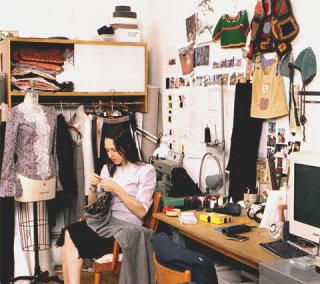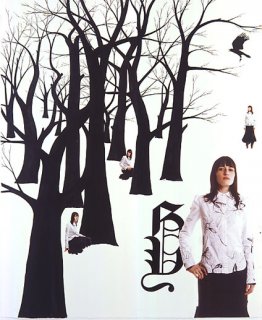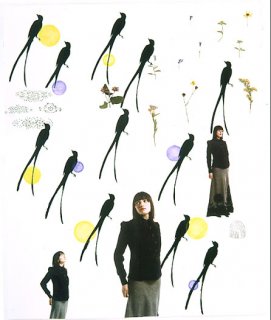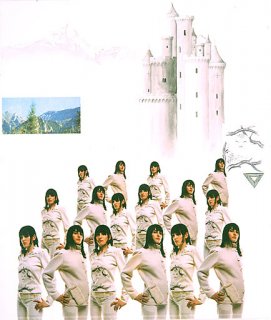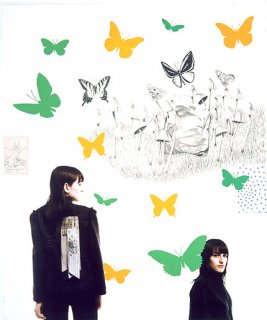-
Share with us... Your Best & Worst Collections of Haute Couture F/W 2025.26
You are using an out of date browser. It may not display this or other websites correctly.
You should upgrade or use an alternative browser.
You should upgrade or use an alternative browser.
Tess Giberson
- Thread starter Psylocke
- Start date
Not Plain Jane
Well-Known Member
- Joined
- Mar 3, 2010
- Messages
- 15,452
- Reaction score
- 772
I've loved her recent collections so thanks for the thread -  Hopefully we can hear more from her about the creative process, inspirations, and so on. I love how normal her life sounds (soccer field, etc) and I totally agree: beach, country AND city. Why limit?
Hopefully we can hear more from her about the creative process, inspirations, and so on. I love how normal her life sounds (soccer field, etc) and I totally agree: beach, country AND city. Why limit? 
 Hopefully we can hear more from her about the creative process, inspirations, and so on. I love how normal her life sounds (soccer field, etc) and I totally agree: beach, country AND city. Why limit?
Hopefully we can hear more from her about the creative process, inspirations, and so on. I love how normal her life sounds (soccer field, etc) and I totally agree: beach, country AND city. Why limit? 
Last edited by a moderator:
wow,as much and as long as i've posted about tess,i'm surprised i didn't already start a main thread for tess. (bow my head in shame)
anyway,i wish we could get some of her archival stuff on here pre-2005....i think you all would be delighted how much her work has evolved but what has also remained true about the work she does and that's her passion for handcrafts.
anyway,i wish we could get some of her archival stuff on here pre-2005....i think you all would be delighted how much her work has evolved but what has also remained true about the work she does and that's her passion for handcrafts.
Psylocke
Active Member
- Joined
- Dec 1, 2009
- Messages
- 10,980
- Reaction score
- 25
13th Aug 2012 | the making of Spring 2013 – Whitewash

tessgiberson.tumblr.com
I was surprised to find you never started a thread on her, too! There were two old threads about her work for TSE, though.wow,as much and as long as i've posted about tess,i'm surprised i didn't already start a main thread for tess. (bow my head in shame)
There are pictures of her pre-2005 collections on her website:
http://www.tessgiberson.com/archive/
Will try to post them here if I find time to do so. I love her earlier work

Btw, I wasn't really successful in finding any other interviews with her; I found one from 2002 and that's it

if i'm not mistaken i could have but in the frenzy of server upgrades a few years ago,it probably got removed or something. not sure.
there was that interview from index,which i think is the one you might be referring to but there was one i could have sworn i posted from that blog-style site(pre-blog explosion) arcade project which seems to be blocking access now. too bad there were some lovely images there from inside her studio and workspace.
there was that interview from index,which i think is the one you might be referring to but there was one i could have sworn i posted from that blog-style site(pre-blog explosion) arcade project which seems to be blocking access now. too bad there were some lovely images there from inside her studio and workspace.
okay,i went i looked through some of my files and i actually saved everything to my computer from that site!! 
this is from 2002(and images from her a/w 02)-
*arcadeproject.org

this is from 2002(and images from her a/w 02)-
Tess Giberson is one of those rare individuals who has a very particular style... and for the past few years, she has managed to maintain an utopian autonomy in the cult of young fashion designers she sells among at Barneys and Seven in New York, and a few other stores word wide (one in Hong Kong; four in Japan). Something separates her, and it is largely to do with her lifestyle.
She lives with her husband, Jon Widman, a painter, amidst many books, records, and CDs in a work/live space in center of the meat packing district. It's white and airy, but somehow the environment feels very cozy. The two often collaborate on Tess's projects - specifically on building the concept of her presentations. His paintings are very delicate graphic works, which somehow organically fuse with the intricate hand stitching that is emblematic of Tess's designs. In fact, their works combine so fluidly - the patterning, attention to detail, subtle symbology -- that you imagine that they are conspiring to extend their marriage into art, rather than collaborating on work. Here's what Tess had to say about this and more...
AP: What is this latest collection based on?
TG: My childhood experiences; the clothing and toys my mother made for us growing up... and fantasy.
AP: Tell us a bit about your childhood. TG: I was raised in New Hampshire, and when I was growing up, my mom made pretty much everything: our clothing, our animals, all of our food... we had this big garden in the back of our house.
AP: I want to know more about the elaborate hand-stitching on your garments.
TG: It has a lot to do with the way I was raised. Both of my parents are artists and they put a lot of value on handwork, and things coming from the hand. My dad's a glass blower, my mom is more multi-disciplinary. When I was young, she worked on a body of collaged fabric pieces. For the past five years or so, she has been working on a series of artists' books and large murals for public art projects... so, those values have a lot to do with the way that I do things now. And that's why I keep the total number of production down, because I want to always have my hand in every single piece I sell.
AP: Your pieces are like limited edition works of art.
TG: Well, now I have help making the bases of the pieces, but all of the handwork I do myself, and it's something I don't ever intend on letting go of. Once I have the base sizes, I am free to do the part that I like to do. Whereas before I was so busy cutting everything out, and sewing up the side seams and putting on the buttons, that by the time I got around to doing the handwork, the stuff that only I could do, I was exhausted.
AP: I have black high-neck shirt of yours that I splurged on one and half years ago, and I will wear it until death. But that piece feels different to me - its more dramatic, darker. The line you showed us the other day has distinct markers of childhood - floral inserts, lighter colors, lace trimmings. Is it a seasonal difference or...?
TG: No, I think it depends on my mood when I'm making it. Because of the nature of the way that I work, it reflects my feelings at that point. And when I was working on this collection, it was a lot about my childhood memories... I spent a lot of time looking of photos of me and my sisters, and I remember the projects we used to do with my mom... I have very good memories about growing up. And I think that's what you are seeing, when you look at the new collection.
AP: Very much so. And that lends itself to another question I had... your ethos seems more like that of an artist, than that which is generally typified by a designer. Do you find your work is more influenced by art than fashion design?
TG: It's not one particular artist, and inspiration for me doesn't come from one particular place - it comes from everything. Again, a lot of comes from how I was raised, but also my friends. I'm always open to absorbing things... there's never any one place that I get inspiration from.
AP: And so on to more personal questions... you went to RISD for your undergraduate degree, in apparel design, which is where you met your husband, whom you often collaborate with, right?
TG: Yes. Jon graduated in '94, and he came to New York City in '95. I moved here right after I graduated in '96. We collaborate on the projects, but it's very important for Jon to have his own identity as a painter. That's what he really does - he has his own shows, his own projects...When I am working on specific projects he'll get involved and help me with the conceptual planning and the design work of the shows, but the actual clothing design he keeps separate from.
AP: And so you two work together often?
TG: Working together on projects doesn't feel like work, it feels very natural.
AP: You're so lucky... TG [Smiling shyly]: I know.
AP: When you say "projects," are you referring to presentations of your work, like the one this past February at Klemens Gasser + Tanja Grunert Gallery in Chelsea? And did you have any shows before that?
TG: The first presentation I did was last October, and it was at Seven. It was great - they just gave me the store for the day. We cleared everything out of it, covered the top half of the walls with black and white paper, and then I had seven mannequins that we put on one side of the room. We wrapped the mannequins with muslin, then Jon had these images that he had screen-printed on paper... we collaged those onto the mannequins. That was our first installation.
AP: It sounds amazing...
TG: It was a good way to start, because it was small. Before that, I was overwhelmed by the idea of actually doing some sort of public presentation... [Tess rises to get some pictures of the event].
AP: What do the initials D.O.R. stand for?
TG: The collection I titled "Daughters of Revolution." It wasn't about a specific revolution, but more about an evolving sense of revolution, on more of an emotional level. The collection was about protection. On every piece I had sewn some sort of talisman within it. I was doing a lot with layering the fabrics, making badges... I realized last summer, before I started working on these pieces, that a lot of the drawings had my version of emblems, like crest details, and one jacket I designed had a kind of badge on the back of it. And so I just thought about why they were there, and where I was placing them. Then I built the whole collection based on this idea, one of calmness, from the sense of protection of where they [the badges] were placed on the body, and the way they felt on the body.
AP: Your sense of the body, your awareness of how things will feel on the body, is quite amazing. I don't think many designers' clothes are made with the actual body in mind...
TG: My process of working is very intuitive... it's more about emotions, it's more about feeling. I don't think of the designs as just a sketch. I am interested in the whole aspect of creating a pattern, and that includes how it feels on the body, and the emotion that it brings up in the person wearing it.
AP: How does that psychological sensitivity reflect in your process of creating a piece?
TG: There's not a static way that I work, it's always changing. Sometimes I start with a pattern, sometimes with a fabric... it depends on what appeals to me emotionally at that particular point.
AP: Do you think the distinctiveness of the hand stitching will always be an element of your work?
TG: I think so, because that's really my way of drawing, those are the marks, and each season I add to it, but I am always maintaining certain things from previous collections. The accumulations of stitches have had the most continual presence in the pieces.
AP: It's like an artist building a distinctive body of work...not like a designer, who's usually more motivated by trends...
TG: That's something I just can't relate to... it's just not natural for me. I'm not really interested in working with trends, thinking what the next thing will be... I think I'd get really bored working that way. I really like the way I work now.
AP: I can think of a number of my favorite female artists who work that way...and it sounds like your mother works that way as well, which I imagine was a huge influence. You said earlier that she works on a project in a particular medium for several years, and then moves on to another project in another medium. Do you see that happening in your future?
TG: Definitely. I love working with clothing, and it may be something that I always do, but I don't want to limit myself to doing just clothing. I'd love to make wall hangings, I'd also love to make sculpture, because a lot of the way that I approach working with the clothing is in a very sculptural way.
AP: On the subject of influence, I almost forgot... do you respond, or refer to any particular era in fashion history, or history in general?
TG: Right now I am actually reading a book on the history of fashion, just because I felt like I haven't really studied the history of fashion in this way since college, where I took a bunch of courses on it. It's very interesting to look at how styles change, and how that reflects the times, and the social and political values of the society. I also love to see the construction of clothing made in the past... there was so much more attention paid to detail. It's much more interesting to look at that, obviously, than at anything current.
AP: Tell me about it...
TG: Again, there's not one specific time that I am more influenced by, and I don't ever like to pull directly from something. I just like looking at fashion history out of interest, rather than direct inspiration for the clothing. But I do love looking at old sewing books, and just the pure construction of the clothing - how seams were finished, or the inside of a garment was treated... those sort of tips are really invaluable.
AP: I was wondering about this with your designs, all being handmade, and so unique... how do send them out into the world of fashion?
TG: In an ideal world I'd love to give away the pieces, and make it so that it [the clothing] was affordable to everyone, but that's not possible. First of all, I have to make it worth the time of doing it. The prices I put on the clothing don't even cover the time I put into each piece, but I just try to come up with a number that seems to be fair.
AP: Enough about fashion then, back to art. The show at Gasser + Grunert was a pretty extensive collaboration. Do you plan on working with these people again in the future?
TG: Well, once again, it's dependent on the specific project. I can't realize if people are going to be appropriate for a certain project until I've begun to work on it. It has to be organic. For the project at the gallery, it involved a lot of people, and I loved having all of those people be a part of it. The next project again will be working with a lot of people, although it's not the same group. I like bringing new people into this whole thing.
AP: How often do you come out with something new?
TG: So far it's been every season, but I don't want to just get into the routine. I'm planning to do another show in September, and I don't know what I'll do after that. I like to be able to stay open, so that I'm free to work on projects that appeal to me, rather than just doing fashion week. If you think, every year, at the same time of year, to feel imposed with a due date...
AP: And the same people, the same time cycle, the same routine...
TG: Yes. And so I want to make sure I keep things open, to bring energy to each new creation... so that the ideas don't get watered down and less inspired. To show every season is not necessary. The fear that people will forget about you can't be the only motivation to doing things.
AP: I really don't think you need to worry about that.
*arcadeproject.org
Attachments
Psylocke
Active Member
- Joined
- Dec 1, 2009
- Messages
- 10,980
- Reaction score
- 25
What a fantastic interview! 
 Karma for you!
Karma for you!
I just love when highly creative people come across so modest and at ease with themselves. She seems so dedicated to what she does and it all seems to come to her so naturally. That was really wonderful to read, it's nice to know what she is like personality-wise, though I do think a lot of it shines through in her collections, too.

 Karma for you!
Karma for you!I just love when highly creative people come across so modest and at ease with themselves. She seems so dedicated to what she does and it all seems to come to her so naturally. That was really wonderful to read, it's nice to know what she is like personality-wise, though I do think a lot of it shines through in her collections, too.
hellimaria
Member
- Joined
- May 20, 2005
- Messages
- 100
- Reaction score
- 5
[FONT=Helvetica, Verdana, sans-serif] [/FONT]
[/FONT]
After shuttering her namesake collection in 2005 to become Design Director at TSE (a position she held until the summer of 2008),Tess Giberson is re-launching her signature collection for spring 2010.
Full of refined, modern staples (read: coated linen anorak, twist-back tank dress, asymmetric tuxedo jacket, skinny black pants), Giberson’s new line, which will be sold at Ron Herman and Louis Boston, is also exceptionally wallet-friendly, with jersey tops retailing for $88 and a lace-trimmed coat topping out at $425. “The idea was to design an accessible collection without compromising either quality or my vision,” the RISD-trained Calvin Klein alum said of the line she founded with business partner, Harriet Lau. “Spring was designed as an introduction, to create a starting point for me to build from. I simply wanted to design strong pieces with great details.”
Done and done.
The Fashion Informer sat down with the New Hampshire-bred, New York-based mother of two just before the holidays to talk books, fashion and family.
So, Tess…
What’s your idea of a perfect weekend?
Sleeping past 7 and spending time with friends/kids without making complicated plans.
What was the last book you read, and would you recommend it?
White by Kenya Hara. Yes, I’d recommend this to others.
Tell me about your family.
My husband is an artist. We met back at college and have worked closely together since. We have two children; a son who’s four-and-a-half and a daughter who’s almost two.
Who is your ideal customer for the new line?
A strong, confident woman with an independent sense of style.
What are you currently wearing?
Pieces from my original Tess Giberson collection and black jeans.
When you were 9, what did you want to be when you grew up?
An interior designer or lawyer.
How often do you get a mani/pedi, and what are your go-to colors?
Not often enough! It’s too hard to find the time between work and kids. When I do I either go very dark or very pale, depending on my mood.
What’s your favorite way to relax/recharge?
Sleep and a spa day.
If you found $15,000 cash in a brown paper bag, how would you spend it?
Splurge a little on my family.
Your designs have been labeled “arty” and “crafty.” How would you describe your aesthetic?
Balanced irreverence.
What song/musician has had the biggest impact on you?
CAN’s Ege Bamyasi. It’s something I’ve been listening to a lot recently.
What did you have for breakfast this morning?
Eggs, toast and coffee.
What makes you nervous?
Too many things to mention.
When are you happiest?
Watching my children.
Photo by KT Auletta
(thefashioninformer)
After shuttering her namesake collection in 2005 to become Design Director at TSE (a position she held until the summer of 2008),Tess Giberson is re-launching her signature collection for spring 2010.
Full of refined, modern staples (read: coated linen anorak, twist-back tank dress, asymmetric tuxedo jacket, skinny black pants), Giberson’s new line, which will be sold at Ron Herman and Louis Boston, is also exceptionally wallet-friendly, with jersey tops retailing for $88 and a lace-trimmed coat topping out at $425. “The idea was to design an accessible collection without compromising either quality or my vision,” the RISD-trained Calvin Klein alum said of the line she founded with business partner, Harriet Lau. “Spring was designed as an introduction, to create a starting point for me to build from. I simply wanted to design strong pieces with great details.”
Done and done.
The Fashion Informer sat down with the New Hampshire-bred, New York-based mother of two just before the holidays to talk books, fashion and family.
So, Tess…
What’s your idea of a perfect weekend?
Sleeping past 7 and spending time with friends/kids without making complicated plans.
What was the last book you read, and would you recommend it?
White by Kenya Hara. Yes, I’d recommend this to others.
Tell me about your family.
My husband is an artist. We met back at college and have worked closely together since. We have two children; a son who’s four-and-a-half and a daughter who’s almost two.
Who is your ideal customer for the new line?
A strong, confident woman with an independent sense of style.
What are you currently wearing?
Pieces from my original Tess Giberson collection and black jeans.
When you were 9, what did you want to be when you grew up?
An interior designer or lawyer.
How often do you get a mani/pedi, and what are your go-to colors?
Not often enough! It’s too hard to find the time between work and kids. When I do I either go very dark or very pale, depending on my mood.
What’s your favorite way to relax/recharge?
Sleep and a spa day.
If you found $15,000 cash in a brown paper bag, how would you spend it?
Splurge a little on my family.
Your designs have been labeled “arty” and “crafty.” How would you describe your aesthetic?
Balanced irreverence.
What song/musician has had the biggest impact on you?
CAN’s Ege Bamyasi. It’s something I’ve been listening to a lot recently.
What did you have for breakfast this morning?
Eggs, toast and coffee.
What makes you nervous?
Too many things to mention.
When are you happiest?
Watching my children.
Photo by KT Auletta
(thefashioninformer)
softgrey
flaunt the imperfection
- Joined
- Jan 28, 2004
- Messages
- 52,980
- Reaction score
- 408
she opened a store in downtown nyc a couple yrs ago...
i got a piece from that first collection when she relaunched her own brand, but i haven't been so thrilled with the subsequent (most recent) collections...
i do have a lot of stuff from when she was at TSE and it's in heavy rotation in my wardrobe during the winter...
 ...
...
thanks for digging out the old info scott and for getting the ball rolling again psylocke...

i got a piece from that first collection when she relaunched her own brand, but i haven't been so thrilled with the subsequent (most recent) collections...
i do have a lot of stuff from when she was at TSE and it's in heavy rotation in my wardrobe during the winter...
 ...
...thanks for digging out the old info scott and for getting the ball rolling again psylocke...

Psylocke
Active Member
- Joined
- Dec 1, 2009
- Messages
- 10,980
- Reaction score
- 25
I love that she's already posting Fall 2013 previews on her Tumblr, looks great! 
24th Oct 2012

10th Nov 2012


24th Oct 2012

Sneak Peek: Fall 2013 Experiments
10th Nov 2012

tessgiberson.tumblr.comBehind the Scenes: Taking it Apart, FW13
#Fall 2013 #behind the scenes #tess giberson #fashion #deconstruction
Psylocke
Active Member
- Joined
- Dec 1, 2009
- Messages
- 10,980
- Reaction score
- 25
Similar Threads
- Replies
- 35
- Views
- 4K
- Replies
- 6
- Views
- 2K
Users who are viewing this thread
Total: 1 (members: 0, guests: 1)




